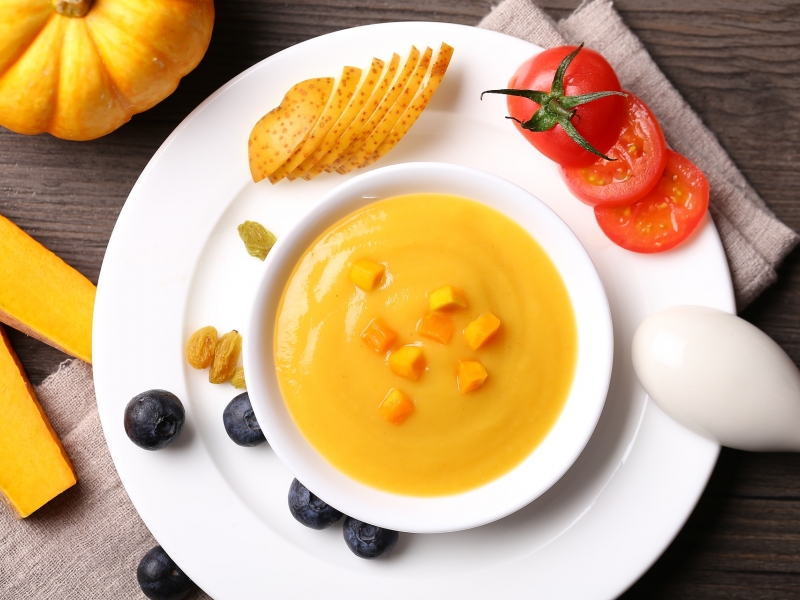You can read a lot about baby food on the Internet. Sometimes the information varies, sometimes it is even at cross purposes. Therefore, it is sometimes more difficult to know when to start with solids than it really is. How to?
To make it easier to find your way, we present a few basic rules fort solids, which will make it a doddle to compile a menu for the youngest of diners.
1. When to start?
If your baby is doing well and if you are fully breastfeeding, you can start introducing foods at the end of six months. If you feed your baby formula and it is hungry, even though it drinks 1 litre of dairy-based nutrition a day, you can start with solids from the end of the fourth month.
2. Veggies first
It is best to start with one type of vegetable. Carrots or pumpkins are good to start with. Over the next few days you can add potatoes, broccoli, courgettes, parsnips, spinach, and later even beets or cauliflower.
3. Preparing vegetable solids
Vegetables retain the most vitamins when steamed. Another option is to boil them until soft, preferably in special water for babies. Pay attention to nitrate levels in tap water, they are dangerous for children under half a year. Add a bit of good- quality oil to the vegetables (to absorb fat-soluble vitamins). “Serve the baby’s food in the form of a smooth puree, you can either sieve the vegetables or liquidize them. In a few weeks, when the child is older and is used to the vegetables, you can slowly start to serve it in pieces. First, mash the vegetables with a fork, later on you can leave even larger pieces, depending on how the child manages it,” is what paediatrician Dr. Lucie Skalova recommends.
4. How much?
Start with one or two teaspoons of baby food, depending on how the baby likes it, and keep breastfeeding the baby. Gradually increase the amount of food. “If the child eats approximately 125g of food, stop breastfeeding and give it special water for babies by spoon or bottle instead of milk,” says Dr. Lucie Skalova.
5. The three days rule
Try a new type of vegetable for 2-3 days so that if there are any allergies they will manifest, and you can know for sure what caused them. You can offer new vegetables separately or with some tried and tested types.
6. Meat
Start with meat about two to four weeks after the introducing vegetables. Boil the meat thoroughly and liquidize or grind finely. The baby will like it more if you mix it with tastes it already knows. For example, make carrots with potato and meat. It is best to start with chicken, turkey or rabbit, later try veal, beef or lamb. “Do not include fish in the diet until around the age of 10 months, first freshwater, then saltwater fish. Meat should be part of the vegetable baby food 7 times a week, or it can be replaced once a week with boiled egg yolk,” Dr. Lucie Skalova adds.
7. Fruit
If you started with solid food after the 6th month, start with fruit between the 7th and 8th month. That is, only after introducing vegetables and meat. Offer it in the morning or as an afternoon snack. At the beginning, peel the fruit, simmer briefly and mix it, later you can just mash it and serve it fresh. At the start it’s best to serve apples, pears, bananas, later apricots, plums, nectarines, peaches, grapes or blueberries. Because of the risk of allergies, do not introduce citrus fruits until around one year of age.
8. Porridge
Between the 8th and 9th month you can add a cereal-milk solid meal in the form of a porridge to replace evening breastfeeding. Porridge can be made from various cereals: corn, rice, oats, wheat, millet, buckwheat, etc. “As concerns gluten, it was previously recommended to introduce gluten between the end of the 4th and 6th month, now, according to the latest recommendations, gluten can be introduced between the end of the 4th and 12th month,” says Dr. Skalova. Do not sweeten the porridge, instead of sugar you can add fruit or fruit puree to it. If you decide to prepare bought porridge, then prepare non-dairy porridge with mother’s milk or artificial milk, and dairy milk porridge with special water for babies.
9. What next?
Between the 9th and 12th month, you can serve food with side dishes (potatoes, rice, pasta, couscous, etc.). You can start with legumes, but be careful, they can cause a lot of flatulence. Feel free to try green peas at 7 months, then other legumes in this order: red lentils, peas, continental lentils, beans. At this age your small diner will also appreciate rolls, hard cheeses and sour dairy products. You can offer good-quality white yogurt to your baby after 7 months. You can try quark from the 10th month. Around the 9th month, the baby is ready for thicker food, so try mixing sliced pieces into a crushed puree and slowly bring the consistency of the baby’s food closer to that of an adult’s. Let the baby hold the food in its hand and let it eat with a spoon, so that it can gradually practice using cutlery. It will be happy to be able to eat with the whole family at a large table in a high chair.
10. What to avoid?
Do not use any flavourings, do not add salt or season until the first year of age. Avoid sweets and cold cuts. Wait until the first year before giving egg white. Do not serve untreated cow’s milk. You can use it to prepare meals from the first year, and as a separate drink at the age of two. Low-fat foods are not intended for children either. Up to two years, the best foods are full-fat, then, later on, semi-fat. If you offer babies harder pieces of food (raw carrots, apples, grapes, etc.), they should always be watched and they should eat in a chair so that they do not start to choke.

